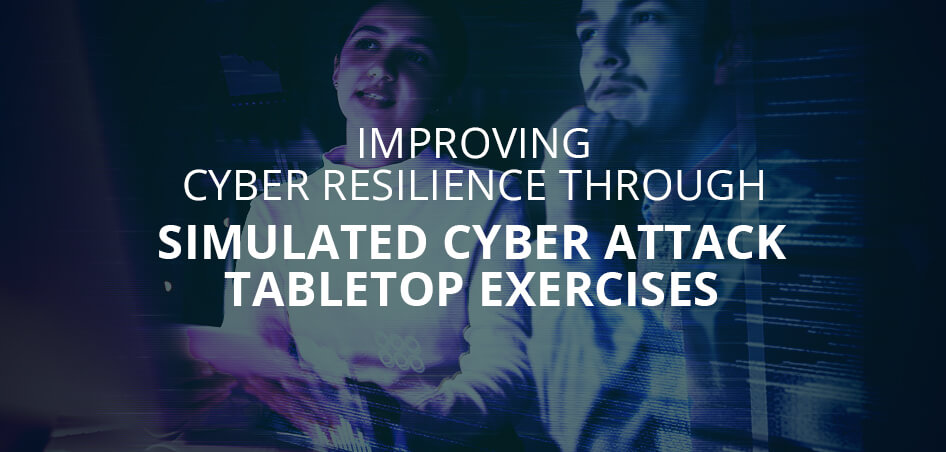
Improving Cyber Resilience through Simulated Cyber Attack Tabletop Exercises
The world is becoming a riskier place when it comes to cybersecurity. We're facing more and more threats like malicious attacks, vulnerabilities being exploited, and data breaches. These things can happen to anyone at any time. That's why organizations are getting smart and preparing themselves with recovery plans to handle these incidents effectively. In 2022, cybersecurity breaches cost a whopping $4.2 million. So, it's crucial to do all we can to get ready and train ourselves before facing a real incident. But here's the question: how can we be sure our plans are good enough, well-practiced, and everyone knows what to do?
Testing our response and recovery plans with simulated events is a tried-and-true method. Just like schools and businesses run fire drills, and emergency services practice for large-scale crises, you can use a cybersecurity tabletop exercise (TTX) to test your incident response plan. It's the closest thing to experiencing a real cyber incident without the actual disaster.
Major Benefits of a Cybersecurity Tabletop Exercise
A cybersecurity tabletop exercise is like a practice run to see how well your company can handle a cyber incident. Think of it as a learning opportunity where there are no mistakes, only chances to get better at what you do.
Here's what you can get out of it:
- Get a better idea of what could happen if a cyber breach occurs, without breaking the bank.
- Keep your company's reputation intact by being open and communicative about the situation.
- Figure out who does what and how decisions are made.
- Find out if your current resources are up to the task.
- Discover any weak points in your planning and fix them.
Best Practices for Conducting Cyber Attack Tabletop Exercises
Set Clear Objectives: To kick things off, you want to have a clear sense of what you're trying to achieve with the tabletop exercise. Are you testing your response plans, checking how well your team communicates, or looking for vulnerabilities? Having specific goals helps keep the exercise focused and meaningful.
Create Realistic Scenarios: Think of scenarios that make sense for your organization and its unique situation. Focus on the kinds of threats that could impact your business and its most important stuff. This not only makes the exercise more engaging but also helps participants learn practical lessons from it.
Here at Amtex-CYGNVS, our facilitators really get to know your organization. We spend time understanding how your business works, its different functions, and collaborate with your team to come up with scenarios that hit home for everyone involved.
Choose the Right Participants: Make sure you involve people from different parts of your organization and at different levels. This mix of perspectives can reveal communication gaps and show you where coordination is crucial. If you want a more targeted approach, consider Cyber Tabletop Exercises designed for specific groups. For instance, we offer workshops tailored for technical folks, executives, and those who focus on operations.
Encourage Open and Constructive Discussions: Create an atmosphere where everyone feels comfortable sharing their thoughts, worries, and ideas. Open discussions are key to sharing knowledge, collaborating effectively, and exploring new approaches to deal with cyber threats.
Document What You Learn: After the exercise, the facilitator provides a detailed report or Executive Summary. It'll include their observations and contributions from each participant. This report highlights the most important takeaways and lessons learned during the exercise.
Pro Tips only for you!
Here are some additional insights into the advantages of conducting a Cyber Attack Tabletop Exercise and how it can strengthen your overall cybersecurity readiness:
Uncovering Weaknesses and Gaps: Tabletop exercises offer a controlled setting where organizations can pinpoint potential vulnerabilities in their existing cybersecurity systems, policies, and procedures.
Evaluating Incident Response Plans: Cyber-attack tabletop exercises provide an ideal opportunity to assess the effectiveness of your incident response strategies. Participants not only get to practice executing their response plans but also help you identify bottlenecks and refine the incident response processes.
Promoting Communication and Collaboration: These exercises encourage collaboration and communication across different departments and key stakeholders. Participants from IT, legal, human resources, public relations, and executive leadership can come together to understand each other's roles and responsibilities in the impact of a cyber-attack.
Cultivating a Culture of Cybersecurity Awareness: Tabletop exercises play a pivotal role in nurturing a culture of cybersecurity awareness within the organization. By involving employees from various departments, these exercises establish a shared understanding of the significance of cybersecurity and the role each individual plays in maintaining a secure environment.
Final thoughts
Imagine cyber-attack tabletop exercises as your secret weapons for boosting your organization's defense against cyber threats.They work by simulating real attack situations and getting your key players to work together. This way, you can figure out where your organization shines and where it needs a bit of buffing.
These exercises are like the ultimate trial run for your incident response (IR) plans. You get to test your strategies, fine-tune your communication, and even create a real buzz about cybersecurity awareness within your team. When you invest time and resources in these exercises, you're basically supercharging your ability to deal with cyber threats. That means reducing the potential damage from cyber-attacks and keeping your most important assets safe and sound. It's like having a cybersecurity shield!





 Back
Back 41
41  94
94